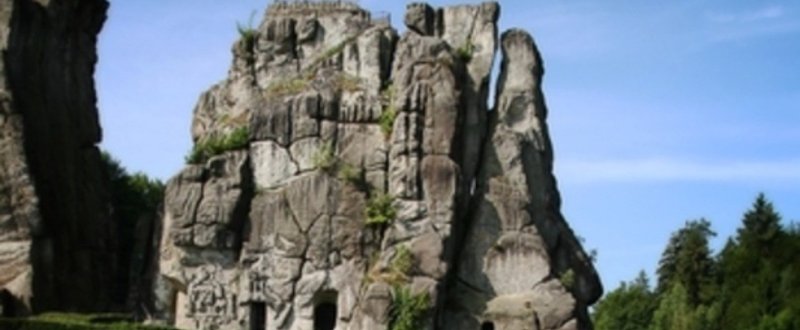
エクスターンシュタイネについて
エクスターンシュタイネ
エクスターンシュタイネはドイツ北部にある、5つの巨大な岩の柱で出来た場所であり、おそらく有史以前から神聖な場所としてみなされてきた。
紛れもなく神秘的て魔術的な場所であるエクスターンシュタイネは、シャルルマーニュが西暦782年にサクソン人の異教を廃止するまでは、異教徒の信仰の中心であったと考えられている。そして、それは中世を通じて、キリスト教の隠者によって使われていた。
エクスターンシュタイネには天文学的な岩の整列やその他の魅力的な特徴があり、ネオペイガニストやニューエイジの多くの愛好者を集めている。

エクスターンシュタイネの歴史
エクスターンシュタイネの初期の歴史についてはわずかにしか知られておらず、正確な起源と意味については学者の世代によって様々に解釈される。少なくとも比較的明らかになっているのは、ドイツの異教にとって重要な聖地であったことである。
一つある大きな部屋は異教徒の司祭のイニシエーションとして使われていたと信じられている。その他にいくつか残っている場所は、12世紀の初め頃に聖なる目的のために使われており、十字軍の逸話にまつわるような聖地として保養をすることが意図されていた。
西暦782年に、皇帝カール大帝はその領土で異教を禁止した。その後まもなく、隠遁者の僧侶たちが、邪悪な力を追い出し場所をキリスト教化するために、エクスターンシュタイネの岩の麓にある洞窟に住みつき始めた。僧侶たちは階段を作り、壁には美しいレリーフを施し、高い頂上を祈ることのできる屋外の壮大な礼拝堂として使った。
中世の後の時代、エクスターンシュタイネは地元の伯爵の手に渡り、その過程で、要塞や宮殿、また監獄などとして様々な用途に使用された。そして、19世紀の初期に元の形へと復元された。
最近の歴史では、エクスターンシュタイネはドイツ国家主義者たちの注目を集めており、その中には1933年に「エクスターンシュタイネ財団」を統括するハインリヒ・ヒムラーなども含まれている。今日、エクスターンシュタイネに訪れる訪問者は、ネオナチのような極端な国家主義が理由のものも何人かいる。エクスターンシュタイネからほんの数マイル離れた場所には、ドイツ国家主義のモニュメントであるヘルマン記念碑がある。
今日、エクスターンシュタイネは人気の観光地となっており、同時に多くの精神的な信仰者を引き寄せている。エクスターンシュタイネへの近年の巡礼者の多くは、占星術的な側面や、宇宙のエネルギーなどの関心から、場所に惹きつけられるニューエイジの信者である。ドイツにおける異教の信仰と儀式を信奉するネオペイガンたちも、エクスターンシュタイネに引き寄せられている。これら両方のグループは、夏至と冬至に集まって祝祭を行う。

エクスターンシュタイネで何が観れるのか?
エクスターンシュタイネは石灰岩の柱で出来た5つの奇岩群であり、その最も高いもので37.5mとなっている。その石柱群は数世紀をかけて、人の手によって美しく神秘的な方法で加工され、装飾が施されている。開けられた理由がよく分からない穴、行き止まりになった階段、用途が不明な舞台、そして真夏の日の出に面した大きな空間。開けられた穴は、他の聖地の岩のように、地球内部のエネルギーを解放するための入り口として象徴化されている可能性もある。
石柱の一つには、頑丈な金属の橋によって頂上にアクセスすることができ、そこには岩を掘って造られた小さな柱上の祭壇のある屋根のない礼拝堂が設けられている。20インチの丸窓には、真夏の日の出と最北端に登る月の光が差し込みます。
夏至の最初の光線は、祭壇の後ろの壁の中央に光の円弧を切り取り、光のビームが祭壇の上にもともと置かれていた聖なるオブジェクトを照らしていたであろう。中世の時代、キリスト教の僧侶たちはこの礼拝堂で祈り、おそらくそれ以前は、異教徒たちによって12星座を通る太陽の軌道を計測するための観測所として使用されていたと考えられる。
エクスターンシュタイネにおける中世の隠遁者によって刻まれた数々の美しいレリーフ。それらの多くは、12世紀の壁面レリーフであるクロス(または生命の木)を踏襲しており注目に価する。その彫刻はロマネスク様式であるが、ビザンチン芸術の影響を大きく受けており、ドイツにおけるビザンチン彫刻の例として唯一知られている例である。
このレリーフは「イルミンスール」を表現しており、大地の力を象徴する異教の樹木あるいは柱、十字架を背負いお辞儀しているイエスの身体として崇拝されている。ニコデモの十字架を背負うイエスのように、イルミンスールの上に自重で覆いかぶさっている。
異教にとって豊穣の象徴である太陽と月は泣いている。異教にとっては大地の力のシンボルであり、キリスト教において邪悪な力の象徴である蛇が信奉者の足元の大地へと押し戻されている。
僧侶たちが住みついた洞窟にある一連のレリーフについては、閉鎖されておらず、そのうちの一つは、1115年に礼拝堂として献堂されたという銘板が残っている。


Externsteine, a site consisting of five enormous rock pillars in northern Germany, has probably been regarded as sacred since prehistoric times.
An undeniably mysterious and magical place, Externsteine is thought to have been a pagan cultic center until Charlemagne abolished Saxon paganism in 782 AD. It was then used by Christian hermits throughout the Middle Ages.
Externsteine contains a number of astronomical alignments and other fascinating features, and attracts many devotees of Neopaganism and New Age religion.
History of Externsteine
Little is known about the early history of Externsteine, and its precise origin and significance has baffled generations of scholars. It is relatively clear, at least, that it was an important shrine for Germanic paganism. One large room is believed to have been used to initiate priests in the cult. Some maintain, however, that the site was used for sacred purposes beginning in the 12th century, and was intended as a re-creation fo the Holy Land inspired by Crusader's tales.
In 782 AD, Emperor Charlemagne prohibited the practice of paganism in his lands. Shortly thereafter, hermit monks settled into caves in the base of the rocks at Externsteine, probably to Christianize the site and drive out its evil powers. The monks carved staircases and beautiful reliefs in the walls, and used a spectacular roofless chapel atop a high pillar for prayer.
After the Middle Ages, Externsteine passed to the local counts and served successively as a fortress, a pleasure palace and a prison, undergoing many alterations in the process. It was restored to its original form early in the 19th century.
In recent history, Externsteine has received the attention of German nationalists, including Heinrich Himmler, who in 1933 presided over the "Externsteine Foundation." Some visitors to Externsteine today are still motivated by extreme nationalism, even neo-Nazism. Just a few miles from Externsteine is Hermanns Denkmal, a monument to German nationalism.
Today, Externsteine is a popular tourist attraction but it also draws many spiritual devotees. Most modern pilgrims to Externsteine are New Age followers, who are attracted to the site by its astrological aspects and perceived cosmic energy. Neopagans, who identify with the beliefs and rituals of Germanic paganism, are also drawn to Externsteine. Both groups celebrate winter and summer solstices at the site.
What to See at Externsteine
Externsteine is a natural outcropping of five limestone pillars, the tallest of which is 37.5m high. The pillars have been modified and decorated by humans over the centuries in a variety of fascinating and mysterious ways: holes were drilled for no apparent reason; stairs lead to dead ends; platforms serve no clear purpose; and a large space faces the midsummer sunrise. The holes may have symbolized entry-points into the earth to release its energies, as at other rock sanctuaries.
Atop one of the pillars, accessible by a sturdy metal footbridge, is a roofless chapel with a tiny pillar altar carved out of the rock. A 20-inch round window provides a view of the midsummer sunrise and the most northerly rising of the moon.
The first rays of the summer solstice cut an arc of light in the center of the wall behind the altar; the beam of light may have originally rested on a sacred object that was placed on the altar. Christian monks prayed in this chapel in the Middle Ages, and it was likely used as a pagan observatory—perhaps for tracking the sun's path through the zodiac—before that.
A number of beautifully carved reliefs were left by the medieval hermits at Externsteine, the most notable of which is a spectacular 12th-century wall relief of the Descent from the Cross (also called the Tree of Life). The sculpture is Romanesque in style, but heavily influenced by Byzantine art—it is the only known example of Byzantine sculpture art in Germany.
The relief depicts the Irminsul, a pagan tree or pillar representing earth power, bowing down in adoration as the body of Jesus is taken from the cross. As Nicodemus lowers Jesus from the cross (John 19:39-40), he steps on the Irminsul, which curves under his weight.
The sun and moon—important pagan fertility images—are weeping. A snake, the symbol of earth energies in paganism and of evil power in Christianity, is pushed down into the earth beneath the disciples' feet.
To the side of the relief is a series of caves inhabited by the monks, which are no closed off. One of them bears an inscription saying it was consecrated as a chapel in 1115.
References
Norbert C. Brockman, Encyclopedia of Sacred Places(Oxford University Press, 1998), 77-79.
Gordon McLachlan, The Rough Guide to Germany 6 (2004), 572.
Externsteine - Stadt Horn-Bad Meinberg
More Information
Externsteine - Megalithic Portal
Germanic Paganism - ReligionFacts
Paul Devereux, Secrets of Ancient and Sacred Places (London: Blandford, 1992).
Walter Matthes, Corvey und die Externsteine (Stuttgart: Urachhaus, 1982).
Photos of Externsteine - here on Sacred Destinations
この記事が気に入ったらサポートをしてみませんか?
